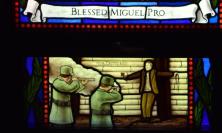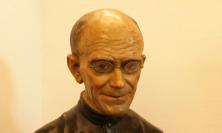Peter-Hans Kolvenbach, 29th superior general of the Society of Jesus (in office 1983-2008) summarised Jesuit history in ‘centuries’, characterised by the dominant groups in successive periods, so there were Portuguese, Spanish, German, French and North American centuries. We are now in the Indian century. Michael Walsh, who has a Jesuit background, boldly undertakes what he describes as ‘yet another single volume’ history of the Catholic Church’s most controversial religious order.
A group of ten graduate students at the University of Paris in 1540 gathered around Ignatius of Loyola, a Basque who had been trained ‘as a courtier, not as a soldier’; the Society had grown into a thousand-member religious order by 1556, the year Ignatius died. This growth came from the very broad aims of the Society (‘For the glory of God and the salvation of souls’) and its vitality, from the enthusiasm ignited by the Spiritual Exercises (Ignatius’s retreat manual), and from the Jesuit custom of keeping and sharing regular reports of their activities. The reporting and sharing created a strong spirit of solidarity. The delegation of responsibility encouraged local initiative by Jesuits and made their work more effective.
Jesuits were adept at dealing with the powerful, from Pope Paul III (whose grandson’s unhappy marriage was improved by Ignatius’s counselling) to the rulers of Bavaria, who placed themselves in the front line of opposition to Protestantism. Walsh, however, is correct in stressing that Jesuits did not set out to combat Protestant teaching, nor did they plan to become educators, but both were their responses to invitations and to challenges. The first college was opened at Messina, in 1548. By 1560, all Jesuit seminarians had to spend some time teaching. In most cities of Catholic Europe, we can still see the (usually now former) Jesuit church and the adjoining college. The colleges offered free education to boys. The churches looked similar: flat-fronted, with the high altar visible from every seat and side altars dedicated to Jesuit saints, especially Ignatius himself and his contemporary Francis Xavier, who was the great Catholic missionary hero of the age.
It was, however, through the sodalities, the Marian congregations, that Jesuits had their greatest influence. On page 219, the author gives a helpful summary of the aims and growth of the Sodality (founded by a Belgian Jesuit at Rome in 1563). All the branches were linked to Rome and the membership was open to vast numbers of men and women. In Munich, the men’s sodality bought a warehouse and transformed it into a church, which is still in use. The Sodality was partial compensation for the absence of a female branch of the Society, in an era when all women religious were cloistered.
Rural preaching in Catholic countries was immensely important. John Francis Regis is the best-known of the many Jesuit priests who led ‘parish missions’, giving basic instruction to vast numbers of people who had deep faith, but who knew little of doctrine. This was part of a movement that tried to ensure that a Catholic church should be within six miles of any rural settlement, because that was thought to be the distance most people could walk to attend Mass.
The author describes, at length, the disputes between Jesuits and Dominicans about divine grace, but some of that space should have been given to Jesuit art and architecture. The best Jesuit architects were brothers, not priests, as were the artists. Brother Daniel Seghers, whose paintings of flowers hang in galleries all over Europe, was the most talented Jesuit painter. Drama and music were encouraged by all Jesuit colleges. The most gifted composer was Domenico Zipoli, who died in Argentina, before ordination, in 1726.
Francis Xavier sailed from Lisbon to India in 1541, beginning a long and very extensive Jesuit missionary outreach. Xavier helped to lay the foundations of Japanese Catholicism (later almost completely destroyed by persecution), but he died as he tried to enter China. Walsh follows tradition in concentrating on the work of later Jesuits amongst the elites in China and India, but recent research now emphasises the success of lesser-known men who made large numbers of converts amongst the humbler folk in both regions.
There was an impressive, but ultimately unsuccessful, Jesuit attempt to link the Ethiopian Church with Rome. The author gives a very helpful summary of Jesuit contacts with Central Africa and with Egypt. In the 1590s, Pedro Páez SJ, spent several years in Muslim captivity near Yemen and became one of the first Europeans to mention drinking coffee.
In the history of such a large and varied religious order, there is light and there is darkness. The thirty ‘reductions’, which protected native peoples in Paraguay are a superb story. Less encouraging is the official endorsement of anti-Semitism by the highest Jesuit authorities, beginning in 1593. Several of the most important early Jesuits had Jewish roots, including Diego Laínez, successor to Ignatius as superior general, but the ban on Jewish novices was lifted only in 1946. Darker still is the acceptance of slavery as simply another form of business, which led to Jesuit priests trading slaves in West Africa and using slave labour on vast sugar plantations in Brazil. This bewildered contemporaries, who noticed that the Jesuits opposed the enslavement of native peoples and the use of forced labour in silver mines, but were untroubled by their ownership of African slaves. This collective blindness continued into the nineteenth century; in 1838, the Maryland Jesuits ignored local opposition and sold their remaining 272 slaves, thus ending, in the worst possible way, a shocking aspect of the Society’s history.
The Jesuit intellectual tradition is well covered here, with useful summaries of the towering achievement of Francisco Suarez (1548-1617) and the controversy provoked by Juan de Mariana (1536-1624), who justified tyrannicide. There was official applause for Robert Bellarmine’s definition of the Church as essentially hierarchical, but his opinion that papal power had some limits ensured that he was not beatified until 1923, almost 300 years after his death. He was canonised in 1930.
Obsession with the Enlightenment encourages historians to undervalue eighteenth century Catholicism. It flourished, nowhere more so than in the Society of Jesus. In 1750, there were more than 20,000 Jesuits, who taught in over 700 colleges and ministered in more than 1,200 churches. Jesuits were beginning to work in the remotest parts of Mexico and in the High Andes. All of that impressive achievement was destroyed between 1759, when Jesuits were expelled from Portugal, and 1773, when a papal brief (less important than a ‘papal bull’) suppressed the Society.
Walsh gives a very good account of the expulsions and eventual suppression of the Society of Jesus, when over-mighty Catholic kings prevailed and a weak papacy sacrificed a vibrant religious family. He understates the brutality of the process, which was the first step in the destruction of many religious orders in the aftermath of the French Revolution and the wars that followed. Only one Benedictine monastery (in Switzerland) was able to survive without interruption, as was a Cistercian monastery near Vienna.
Catherine the Great of Russia and the Prince-Bishop of Liége should have a special place amongst the very long list of Jesuit benefactors, because her decision of keep a couple of hundred Jesuits as teachers and his decision to keep ex-Jesuits together, also as teachers, were essential to the restoration of the Society. Pope Pius VII’s approval of the restored Society in 1814 was part of the restoration of many religious communities in the aftermath of the Napoleonic Wars. Recovery was slow and, by 1820, there were only 436 Jesuits in twenty houses.
The Society of Jesus after 1814 occupies only 61 pages of this book, which is normal in broad accounts of Jesuit history, because the earlier centuries seem more varied and more interesting. ‘Restored or Renewed?’ is the title of chapter 9 and it defines the difficulty addressed by some historians, who ask if the restored Society was only a pale imitation of its older version. The Jesuits in the nineteenth and early twentieth centuries had to work in a world that was in radical transformation, where the industrial revolution, nationalism and colonialism presented new challenges. Anti-clericalism was abundant, particularly in Catholic countries. Expulsions of Jesuits and other religious were regular occurrences. Costa Rica was the only Latin American country that did not pass anti-clerical legislation. In Spain, the Second Republic went so far as to insert an anti-Jesuit clause in its Constitution. The great lay benefactors of the past had no successors, so the new Jesuit colleges had to charge fees. Monarchies, which had long befriended and then helped to restore the Society, were no longer so secure.
The restored Society became much closer to the papacy (itself under constant attack), so it is not surprising that Jesuits played a major role in the First Vatican Council (1869-70). Jesuit journalism flourished, as popular and cultural magazines were founded in many countries. Anti-clericalism was so strong in Catholic countries that Jesuits were safest, and left undisturbed, in English-speaking countries. It was in Great Britain, Ireland, North America and Australia that Jesuit life flourished, as numbers increased, allowing the opening of new colleges, churches and missions. In the United States, there were 26 Jesuit universities.
The relationship between Jesuits and the papacy was not always harmonious. Jesuits were involved variously in the anti-modernist movement, which repressed speculative theology, but Pius X did not think that Franz Wernz, the then Jesuit superior general, was sufficiently enthusiastic. Pius XI showed exceptional favour to the Society of Jesus and asked Jesuits to draft encyclicals, including his anti-Nazi letter of 1937. A Belgian Jesuit drafted Humani generis (1950), which was Pius XII’s attempt to corral modern theologians. Communication between Paul VI and Jesuit central administration could become complicated. John Paul II was never a great admirer of the Society.
The background to all these developments needs a little more explanation than is given here by Dr Walsh. The spread of Communism led to the disruption of Catholic practice and the dispersal of religious communities in many countries. The rapid growth of the Society in China came to an abrupt halt. There was immense suffering for Jesuits and others in most Communist countries. Only in Poland were Catholics strong enough to endure constant government harassment.
Despite all the problems, Jesuits increased in number, so membership of the Society (at 36,700) was the highest it had ever been precisely as the Second Vatican Council began. Pedro Arrupe was elected superior general in 1965 and served until 1983. His ministry had been in Japan and all his successors were men who had worked outside Europe. Arturo Sosa, the present superior general is Venezuelan. In that context, the election of a Jesuit pope continues to be surprising, but Francis’ Latin American origins are part of a pattern.
Arrupe led the transformation of the Society of Jesus, which altered both the lifestyle and the mode of governance. The daily life of Jesuits (not described in this book) had been regulated, almost monastic, and authority had been austere and harsh. The harshness had become more pronounced in the twentieth century. All this changed, but many could not cope with the changes, nor had they been prepared for them, so thousands of Jesuits left the Society. This was the pattern in many religious communities of men and women, including the high rate of departures amongst those who joined after Vatican II. The cult of unfettered individualism does not sit well with the vowed life.
Michael Walsh’s book is ‘old-fashioned’ in a very good sense. It is based on very extensive reading. There are very few errors, but two are significant: Pedro Arrupe was at Hiroshima when the atomic bomb fell, not at Nagasaki (page 275) and Jesuit priests no longer take the ‘ad gradum’ exam before final vows.
The Society of Jesus, much reduced in size, declines rapidly in Europe and North America, but grows in the Global South. There are now nineteen Jesuit provinces in India; there are waiting lists to enter the Society in Vietnam (where the government restricts the number of seminarians). The apostolate of the Spiritual Exercises now reaches many other churches, including Anglicans and Lutherans, but it remains the basis of the Jesuit vocation in every land.






